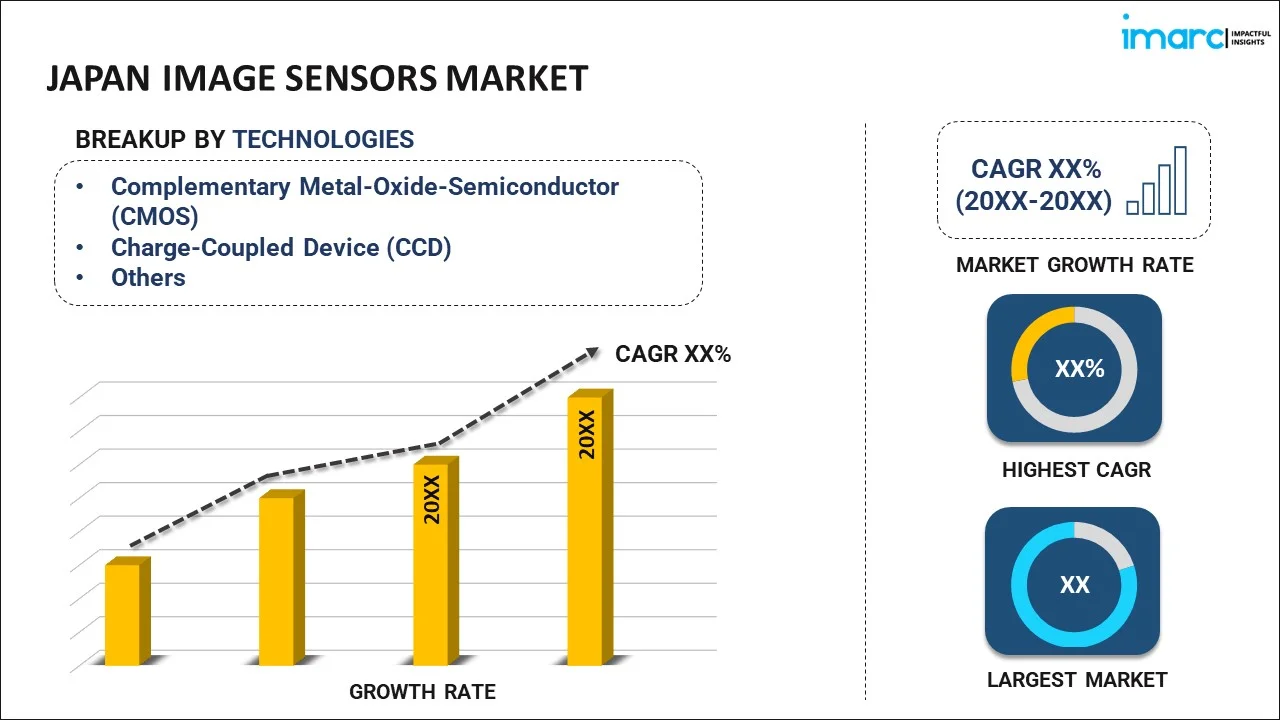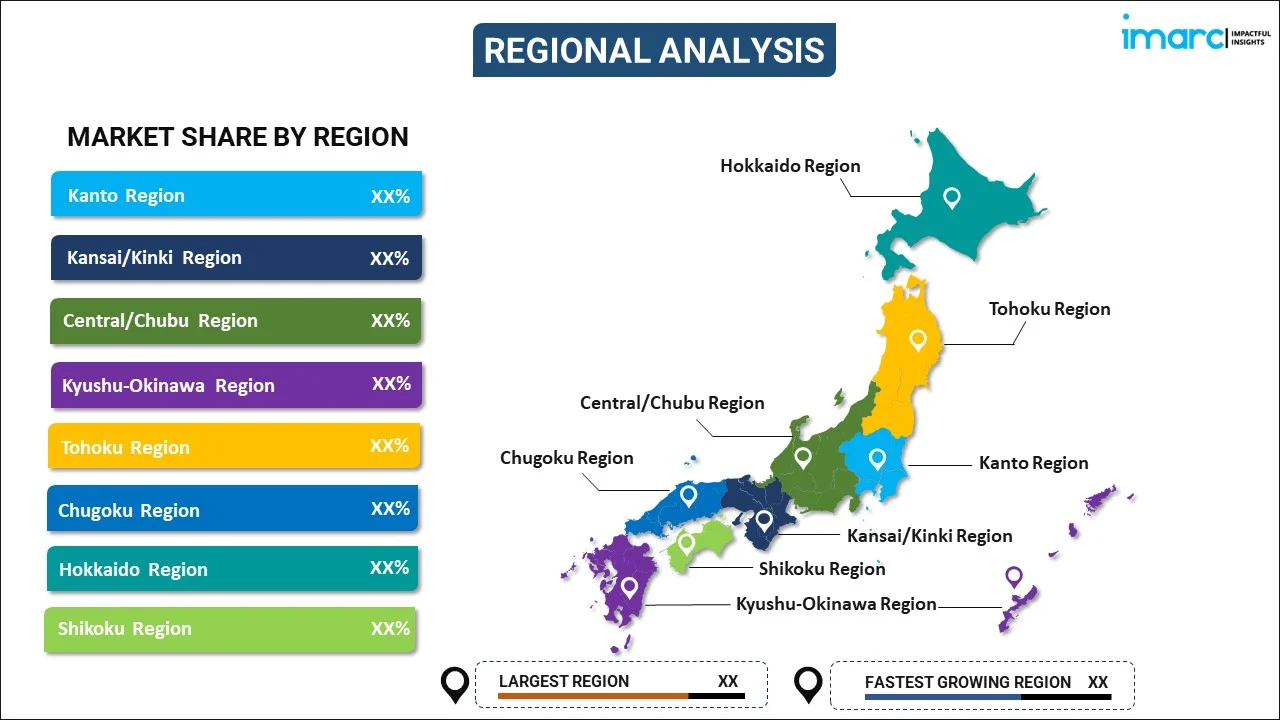
Japan Image Sensors Market Report by Technology (Complementary Metal-Oxide-Semiconductor (CMOS), Charge-Coupled Device (CCD), and Others), Processing Type (2D Image Sensors, 3D Image Sensors), Spectrum (Visible Spectrum, Non-visible Spectrum), Array Type (Linear Image Sensors, Area Image Sensors), End Use Industry (Consumer Electronics, Healthcare, Security and Surveillance, Automotive and Transportation, Aerospace and Defense, and Others), and Region 2025-2033
Market Overview:
Japan image sensors market size reached USD 1,682.2 Million in 2024. Looking forward, IMARC Group expects the market to reach USD 3,415.8 Million by 2033, exhibiting a growth rate (CAGR) of 7.3% during 2025-2033. The widespread adoption of these components that help in enabling advanced camera capabilities is primarily driving the market growth.
|
Report Attribute
|
Key Statistics
|
|---|---|
|
Base Year
|
2024 |
|
Forecast Years
|
2025-2033 |
|
Historical Years
|
2019-2024
|
| Market Size in 2024 | USD 1,682.2 Million |
| Market Forecast in 2033 | USD 3,415.8 Million |
| Market Growth Rate (2025-2033) | 7.3% |
An image sensor is an electronic component that transforms incoming light or photons into an electronic signal, which can then be observed, stored, or processed in devices like machine vision cameras and both analog and digital imaging equipment. It serves as a crucial element in medical camera systems and tools used for night vision, including radar, sonar, and thermal imaging devices, enabling the detection and transmission of information. These sensors are widely available in a variety of packages, formats, structures, color characteristics, resolutions, frame rates, and pixel sizes. Currently, numerous manufacturers are introducing new variations of image sensors featuring enhancements in sensor size, resolution, speed, and light sensitivity.
Japan Image Sensors Market Trends:
The image sensors market in Japan is experiencing significant growth driven by several compelling factors. Notably, the widespread use of smartphones for capturing on-demand photographs is a primary driver, leading to the integration of advanced image sensors in these devices to enable sophisticated camera capabilities. Additionally, the rising trend of connected vehicles, driven by the need to reduce road accidents, is spurring demand for compact, durable, and cost-effective image sensors. These sensors are crucial components in camera-enabled systems for applications such as autonomous driving, video mirrors, rearview cameras, automatic emergency braking, 360-degree surround view, driver monitoring, and enhancing overall safety and comfort in vehicles. Furthermore, image sensors find extensive usage in barcode scanners, particularly in the healthcare industry, where real-time tracking of medical supplies, staff, and assets is essential. The growing demand for medical assistance, driven by the increasing prevalence of chronic diseases, is contributing to the expansion of the market. Leading manufacturers are also introducing advanced image sensors designed for use in closed-circuit television (CCTV) security cameras, meeting the rising demand for video surveillance in residential, commercial, and industrial settings. This heightened demand for CCTV cameras, stemming from growing security concerns, is further bolstering the image sensors market in Japan. Collectively, these factors will create a positive outlook for the market's growth in the country over the forecasted period.
Japan Image Sensors Market Segmentation:
IMARC Group provides an analysis of the key trends in each segment of the market, along with forecasts at the country level for 2025-2033. Our report has categorized the market based on technology, processing type, spectrum, array type, and end use industry.
Technology Insights:

- Complementary Metal-Oxide-Semiconductor (CMOS)
- Charge-Coupled Device (CCD)
- Others
The report has provided a detailed breakup and analysis of the market based on the technology. This includes complementary metal-oxide-semiconductor (CMOS), charge-coupled device (CCD), and others.
Processing Type Insights:
- 2D Image Sensors
- 3D Image Sensors
A detailed breakup and analysis of the market based on the processing type have also been provided in the report. This 2D image sensors and 3D image sensors.
Spectrum Insights:
- Visible Spectrum
- Non-visible Spectrum
The report has provided a detailed breakup and analysis of the market based on the spectrum. This includes visible spectrum and non-visible spectrum.
Array Type Insights:
- Linear Image Sensors
- Area Image Sensors
A detailed breakup and analysis of the market based on the array type have also been provided in the report. This includes linear image sensors and area image sensors.
End Use Industry Insights:
- Consumer Electronics
- Healthcare
- Security and Surveillance
- Automotive and Transportation
- Aerospace and Defense
- Others
The report has provided a detailed breakup and analysis of the market based on the End use industry. This includes consumer electronics, healthcare, security and surveillance, automotive and transportation, aerospace and defense, and others.
Regional Insights:

- Kanto Region
- Kansai/Kinki Region
- Central/ Chubu Region
- Kyushu-Okinawa Region
- Tohoku Region
- Chugoku Region
- Hokkaido Region
- Shikoku Region
The report has also provided a comprehensive analysis of all the major regional markets, which include Kanto Region, Kansai/Kinki Region, Central/ Chubu Region, Kyushu-Okinawa Region, Tohoku Region, Chugoku Region, Hokkaido Region, and Shikoku Region.
Competitive Landscape:
The market research report has also provided a comprehensive analysis of the competitive landscape. Competitive analysis such as market structure, key player positioning, top winning strategies, competitive dashboard, and company evaluation quadrant has been covered in the report. Also, detailed profiles of all major companies have been provided. Some of the key players include:
- Hamamatsu Photonics K.K.
- Sony Semiconductor Solutions Corporation (Sony Corporation)
- Toshiba Electronic Devices and Storage Corporation (Toshiba Corporation)
(Please note that this is only a partial list of the key players, and the complete list is provided in the report.)
Japan Image Sensors Market Report Coverage:
| Report Features | Details |
|---|---|
| Base Year of the Analysis | 2024 |
| Historical Period | 2019-2024 |
| Forecast Period | 2025-2033 |
| Units | Million USD |
| Scope of the Report | Exploration of Historical and Forecast Trends, Industry Catalysts and Challenges, Segment-Wise Historical and Predictive Market Assessment:
|
| Technologies Covered | Complementary Metal-Oxide-Semiconductor (CMOS), Charge-Coupled Device (CCD), Others |
| Processing Types Covered | 2D Image Sensors, 3D Image Sensors |
| Spectrums Covered | Visible Spectrum, Non-visible Spectrum |
| Array Types Covered | Linear Image Sensors, Area Image Sensors |
| End Use Industries Covered | Consumer Electronics, Healthcare, Security and Surveillance, Automotive and Transportation, Aerospace and Defense, Others |
| Regions Covered | Kanto Region, Kansai/Kinki Region, Central/ Chubu Region, Kyushu-Okinawa Region, Tohoku Region, Chugoku Region, Hokkaido Region, Shikoku Region |
| Companies Covered | Hamamatsu Photonics K.K., Sony Semiconductor Solutions Corporation (Sony Corporation), Toshiba Electronic Devices and Storage Corporation (Toshiba Corporation), etc. |
| Customization Scope | 10% Free Customization |
| Post-Sale Analyst Support | 10-12 Weeks |
| Delivery Format | PDF and Excel through Email (We can also provide the editable version of the report in PPT/Word format on special request) |
Key Questions Answered in This Report:
- How has the Japan image sensors market performed so far and how will it perform in the coming years?
- What has been the impact of COVID-19 on the Japan image sensors market?
- What is the breakup of the Japan image sensors market on the basis of technology?
- What is the breakup of the Japan image sensors market on the basis of processing type?
- What is the breakup of the Japan image sensors market on the basis of spectrum?
- What is the breakup of the Japan image sensors market on the basis of array type?
- What is the breakup of the Japan image sensors market on the basis of end use industry?
- What are the various stages in the value chain of the Japan image sensors market?
- What are the key driving factors and challenges in the Japan image sensors?
- What is the structure of the Japan image sensors market and who are the key players?
- What is the degree of competition in the Japan image sensors market?
Key Benefits for Stakeholders:
- IMARC’s industry report offers a comprehensive quantitative analysis of various market segments, historical and current market trends, market forecasts, and dynamics of the Japan image sensors market from 2019-2033.
- The research report provides the latest information on the market drivers, challenges, and opportunities in the Japan image sensors market.
- Porter's five forces analysis assist stakeholders in assessing the impact of new entrants, competitive rivalry, supplier array, buyer array, and the threat of substitution. It helps stakeholders to analyze the level of competition within the Japan image sensors industry and its attractiveness.
- Competitive landscape allows stakeholders to understand their competitive environment and provides an insight into the current positions of key players in the market.
Need more help?
- Speak to our experienced analysts for insights on the current market scenarios.
- Include additional segments and countries to customize the report as per your requirement.
- Gain an unparalleled competitive advantage in your domain by understanding how to utilize the report and positively impacting your operations and revenue.
- For further assistance, please connect with our analysts.
 Inquire Before Buying
Inquire Before Buying
 Speak to an Analyst
Speak to an Analyst
 Request Brochure
Request Brochure
 Request Customization
Request Customization




.webp)




.webp)












